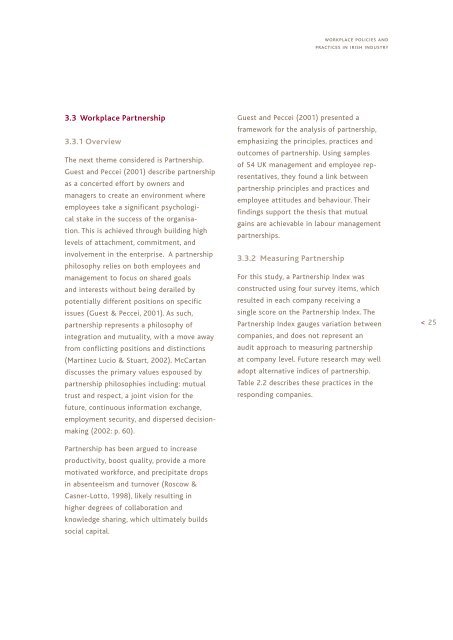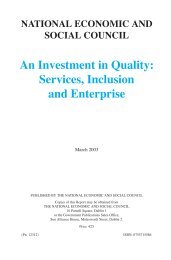New Models of High Performance Work Systems - Equality Authority
New Models of High Performance Work Systems - Equality Authority
New Models of High Performance Work Systems - Equality Authority
Create successful ePaper yourself
Turn your PDF publications into a flip-book with our unique Google optimized e-Paper software.
workplace policies and<br />
practices in irish industry<br />
3.3 <strong>Work</strong>place Partnership<br />
3.3.1 Overview<br />
The next theme considered is Partnership.<br />
Guest and Peccei (2001) describe partnership<br />
as a concerted effort by owners and<br />
managers to create an environment where<br />
employees take a significant psychological<br />
stake in the success <strong>of</strong> the organisation.<br />
This is achieved through building high<br />
levels <strong>of</strong> attachment, commitment, and<br />
involvement in the enterprise. A partnership<br />
philosophy relies on both employees and<br />
management to focus on shared goals<br />
and interests without being derailed by<br />
potentially different positions on specific<br />
issues (Guest & Peccei, 2001). As such,<br />
partnership represents a philosophy <strong>of</strong><br />
integration and mutuality, with a move away<br />
from conflicting positions and distinctions<br />
(Martinez Lucio & Stuart, 2002). McCartan<br />
discusses the primary values espoused by<br />
partnership philosophies including: mutual<br />
trust and respect, a joint vision for the<br />
future, continuous information exchange,<br />
employment security, and dispersed decisionmaking<br />
(2002: p. 60).<br />
Partnership has been argued to increase<br />
productivity, boost quality, provide a more<br />
motivated workforce, and precipitate drops<br />
in absenteeism and turnover (Roscow &<br />
Casner-Lotto, 1998), likely resulting in<br />
higher degrees <strong>of</strong> collaboration and<br />
knowledge sharing, which ultimately builds<br />
social capital.<br />
Guest and Peccei (2001) presented a<br />
framework for the analysis <strong>of</strong> partnership,<br />
emphasizing the principles, practices and<br />
outcomes <strong>of</strong> partnership. Using samples<br />
<strong>of</strong> 54 UK management and employee representatives,<br />
they found a link between<br />
partnership principles and practices and<br />
employee attitudes and behaviour. Their<br />
findings support the thesis that mutual<br />
gains are achievable in labour management<br />
partnerships.<br />
3.3.2 Measuring Partnership<br />
For this study, a Partnership Index was<br />
constructed using four survey items, which<br />
resulted in each company receiving a<br />
single score on the Partnership Index. The<br />
Partnership Index gauges variation between<br />
companies, and does not represent an<br />
audit approach to measuring partnership<br />
at company level. Future research may well<br />
adopt alternative indices <strong>of</strong> partnership.<br />
Table 2.2 describes these practices in the<br />
responding companies.<br />
< 25
















